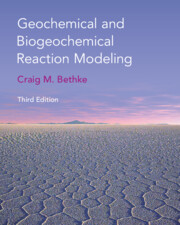Refine search
Actions for selected content:
14 results
3 - Wordhood and Disyllabicity in Chinese
- from Part Two - Morpho-lexical Issues in Chinese
-
-
- Book:
- The Cambridge Handbook of Chinese Linguistics
- Published online:
- 04 August 2022
- Print publication:
- 18 August 2022, pp 47-73
-
- Chapter
- Export citation
14 - Mass Transfer
- from PART II - REACTION PROCESSES
-
- Book:
- Geochemical and Biogeochemical Reaction Modeling
- Published online:
- 09 December 2021
- Print publication:
- 06 January 2022, pp 177-182
-
- Chapter
- Export citation
17 - Kinetics of Dissolution and Precipitation
- from PART II - REACTION PROCESSES
-
- Book:
- Geochemical and Biogeochemical Reaction Modeling
- Published online:
- 09 December 2021
- Print publication:
- 06 January 2022, pp 211-222
-
- Chapter
- Export citation
15 - Polythermal, Fixed, and Sliding Paths
- from PART II - REACTION PROCESSES
-
- Book:
- Geochemical and Biogeochemical Reaction Modeling
- Published online:
- 09 December 2021
- Print publication:
- 06 January 2022, pp 183-196
-
- Chapter
- Export citation
13 - Uniqueness
- from PART I - EQUILIBRIUM IN NATURAL WATERS
-
- Book:
- Geochemical and Biogeochemical Reaction Modeling
- Published online:
- 09 December 2021
- Print publication:
- 06 January 2022, pp 167-174
-
- Chapter
- Export citation
16 - Geochemical Buffers
- from PART II - REACTION PROCESSES
-
- Book:
- Geochemical and Biogeochemical Reaction Modeling
- Published online:
- 09 December 2021
- Print publication:
- 06 January 2022, pp 197-210
-
- Chapter
- Export citation
2 - Modeling Overview
-
- Book:
- Geochemical and Biogeochemical Reaction Modeling
- Published online:
- 09 December 2021
- Print publication:
- 06 January 2022, pp 5-20
-
- Chapter
- Export citation
1 - Introduction
-
- Book:
- Geochemical and Biogeochemical Reaction Modeling
- Published online:
- 09 December 2021
- Print publication:
- 06 January 2022, pp 1-4
-
- Chapter
- Export citation

Geochemical and Biogeochemical Reaction Modeling
-
- Published online:
- 09 December 2021
- Print publication:
- 06 January 2022

Finite Element Method for Solids and Structures
- A Concise Approach
-
- Published online:
- 08 July 2021
- Print publication:
- 17 June 2021
-
- Textbook
- Export citation
Vernal Seedling Emergence Model for Common Lambsquarters (Chenopodium album)
-
- Journal:
- Weed Science / Volume 41 / Issue 2 / June 1993
- Published online by Cambridge University Press:
- 12 June 2017, pp. 309-316
-
- Article
- Export citation
Effects of angular misalignment on material property characterization by nanoindentation with a cylindrical flat-tip indenter
-
- Journal:
- Journal of Materials Research / Volume 32 / Issue 8 / 28 April 2017
- Published online by Cambridge University Press:
- 19 December 2016, pp. 1456-1465
- Print publication:
- 28 April 2017
-
- Article
- Export citation
Using Computer Simulation to Estimate the Need of Ambulances at a Disaster
-
- Journal:
- Prehospital and Disaster Medicine / Volume 17 / Issue S2 / December 2002
- Published online by Cambridge University Press:
- 28 June 2012, p. S84
- Print publication:
- December 2002
-
- Article
-
- You have access
- Export citation
